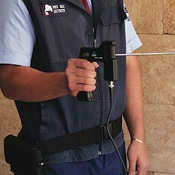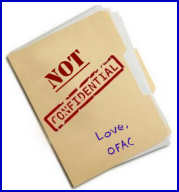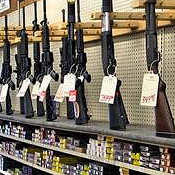In upgrading to WordPress 2.9.1 today, I had a bit of a problem and lost some of the files that control how this blog looks. I’ve recreated most of them, but the blog is still looking a little odd and behaving a bit strangely. I should have time to get everything back in working order over the next few days and while I’m doing that I’ll try to add some new features like a search box.
Archive for January, 2010
31
Upgrade Blues
 Posted by Clif Burns at 6:20 pm on January 31, 2010
Posted by Clif Burns at 6:20 pm on January 31, 2010 Category: General
Category: General
 Permalink
Permalink  Comments Off on Upgrade Blues
Comments Off on Upgrade Blues Copyright © 2010 Clif Burns. All Rights Reserved.
(No republication, syndication or use permitted without my consent.)
28
A Metaphysical Question
 Posted by Clif Burns at 8:49 pm on January 28, 2010
Posted by Clif Burns at 8:49 pm on January 28, 2010 Category: Foreign Export Controls
Category: Foreign Export Controls

ABOVE: The ADE-651
On Tuesday my colleague in our London Office, Anita Esslinger, forwarded to me a directive from British export authorities adding “electro-statically powered explosive detectors” to its list of export-controlled items, otherwise known as the 2008 Export Control Order. Anita wondered if the U.S. was planning on doing the same thing. I wrote back that I didn’t think it would need to since explosive detectors were already covered under ECCN 1A004.d.
In fact, I was wrong, because these “electro-statically powered” explosive detectors aren’t covered by ECCN 1A004.d, but not for the reason that you might imagine, but rather for what might be called a metaphysical reason. These detectors aren’t covered by the ECCN because they don’t work, and, thus, aren’t really bomb detectors. Â At this point, before you accuse of me having read too much Aristotle, hear the rest of the story.
The British order is directed at the ADE-651, a device marketed by a British company named ATSC, which is run by Jim McCormack from a former dairy farm in Somerset. The device, according to ATSC, can detect explosives from a distance of 1 kilometer. Â It can also, allegedly, detect other items such as elephants and dollar bills from the same distance, depending upon whether a card programmed to detect elephants or dollar bills is inserted into the device’s card reader. As a further miracle of modern technology, the device has no power supply but is powered by the static electricity generated by the user, hence, the reference to them as “electro-statically powered” in the amendment to the 2008 Export Control Order.
A BBC Newsnight investigative report (video embedded at the end of this post) examined the device and found that the inside of the device was empty (as in being filled with nothing but air  . . .  literally). The report also discovered that the cards “used” by the device were no more than RFID tags used to deter shoplifting and not specially programmed cards designed to whiff out the essence of elephant or anything else for that matter.
This would be humorous were it not for the fact that the use of these devices may have resulted in death and injury. A recent wave of successful car-bomb attacks in Baghdad has led even some Iraqis to question the efficacy of the device even though Iraq has bought $85 million dollars worth of the non-functional plastic shells at $40,000 to $60,000 per pop.
Jim McCormack has been arrested for fraud and is out on bail.
 Permalink
Permalink  Comments (7)
Comments (7) Copyright © 2010 Clif Burns. All Rights Reserved.
(No republication, syndication or use permitted without my consent.)
27
This Isn’t the Transparency You Were Hoping For?
 Posted by Clif Burns at 8:39 pm on January 27, 2010
Posted by Clif Burns at 8:39 pm on January 27, 2010 Category: OFAC
Category: OFAC
 My colleague Stan Marcuss points out that the Office of Foreign Assets Control (“OFAC”) appears to have changed course in treating Freedom of Information Act (“FOIA”) requests and has decided to hand out OFAC license applications willy-nilly to anyone who can afford a postage stamp. Several years ago, after someone requested copies of all licenses to ship food, medicine and medical devices to Iran, OFAC sent letters to the affected parties asking them if they wished to assert protection under Exemption 4 of the FOIA which exempts from disclosure confidential commercial information. If a licensee asserted the exemption, OFAC normally would withhold the license from disclosure.
My colleague Stan Marcuss points out that the Office of Foreign Assets Control (“OFAC”) appears to have changed course in treating Freedom of Information Act (“FOIA”) requests and has decided to hand out OFAC license applications willy-nilly to anyone who can afford a postage stamp. Several years ago, after someone requested copies of all licenses to ship food, medicine and medical devices to Iran, OFAC sent letters to the affected parties asking them if they wished to assert protection under Exemption 4 of the FOIA which exempts from disclosure confidential commercial information. If a licensee asserted the exemption, OFAC normally would withhold the license from disclosure.
Now, citing the new administration’s policy of transparency, OFAC has sent letters indicating that these licenses will be released to the public. The filing of such a license, and the contents thereof, will be freely disclosed over the objection of the licensee even though such disclosure may discourage some from filing these licenses in the future, clearly in contravention of the Trade Sanctions Reform and Export Enhancement Act of 2000 which clearly sought to encourage the export of such humanitarian supplies to sanctioned countries. Even if we don’t like the government of Iran, Congress passed TSRA because it did not want to see the people of Iran deprived of food and life-saving medicines and medical devices. Those requesting TSRA licenses, of course, don’t really have those interests in mind.
At least two things make OFAC’s new position more than a little absurd. OFAC is still using FOIA Exemption 6 to black out the names of any individuals mentioned in disclosed documents. The absurdity here is that this policy is even used to withhold the names of terrorist and other specially designated nationals (“SDNs”)Â when releasing information on enforcement actions against companies that have engaged in transactions with SDNs. That means, of course, that Osama Bin Laden has more protections under OFAC’s interpretation of the FOIA than an exporter shipping food to a sanctioned country.
Worse, when an agency promises transparency, one might reasonably assume that transparency would extend to providing information on export enforcement cases that might actually assist exporters in trying to interpret and to understand the scope of OFAC’s vaguely worded regulations. Â Not so. Â OFAC continues to release as little information as possible about enforcement actions. Â That sort of transparency would prevent the OFAC from being able to use ambiguities in its own regulations to deter certain exports — a practice I like to call in terrorem regulation.
Apparently, what’s transparent for the goose isn’t really transparent for the gander.
 Permalink
Permalink  Comments (3)
Comments (3) Copyright © 2010 Clif Burns. All Rights Reserved.
(No republication, syndication or use permitted without my consent.)
25
BIS Is from Mars and DDTC Is from Venus
 Posted by Clif Burns at 8:40 pm on January 25, 2010
Posted by Clif Burns at 8:40 pm on January 25, 2010 Category: Arms Export • BIS • DDTC • Part 129
Category: Arms Export • BIS • DDTC • Part 129
 There has never been a seriously-advocated rational reason for the U.S., unlike most other countries, to have one export agency regulating exports of weapons and a separate export agency regulating exports of dual use items. A new regulation adopted by the Bureau of Industry and Security (“BIS”) last May, and which I hadn’t noticed at the time but which was pointed out today by an astute reader, is a perfect example of the confusion sown by this split personality approach to export regulation.
There has never been a seriously-advocated rational reason for the U.S., unlike most other countries, to have one export agency regulating exports of weapons and a separate export agency regulating exports of dual use items. A new regulation adopted by the Bureau of Industry and Security (“BIS”) last May, and which I hadn’t noticed at the time but which was pointed out today by an astute reader, is a perfect example of the confusion sown by this split personality approach to export regulation.
The regulation created a new, and frankly obtuse, ECCN designated as 0A919 which, to the extent any sense can be made of it, covers military items produced outside the United States which incorporate certain thermal imaging devices and which are “not subject to the International Traffic in Arms Regulations.” Don’t go rushing now to your copy of the ITAR to find a definition of items “subject to the ITAR,” because you won’t find it. The Export Administration Regulations (“EAR”) administered by BIS talks about “items subject to the EAR” but the ITAR at times focuses instead on what people are subject to its jurisdiction, particularly in respect to Part 129’s brokering regulations which intersect uncomfortably with the new ECCN.
Let’s now look at a specific example and see what happens. Consider a military vehicle which incorporates a thermal imaging camera controlled by BIS and which was manufactured outside the United States. If a U.S. person sought to export that vehicle from its country of manufacture to another country, that person (depending on the value of the vehicle and its export destinations) could be required to get permission from the Directorate of Defense Controls (“DDTC”) which regulates brokering in Part 129 of the ITAR. And given the new ECCN, that person might also require an export license from BIS (depending, of course, on the destination of the exported vehicle).
BIS tries unsuccessfully to avoid this overlapping jurisdiction with an awkwardly worded note to the new ECCN:
Brokering activities (as defined in 22 CFR 129.9) of military commodities that are subject to the ITAR are under the licensing jurisdiction of the Department of State.
That note doesn’t work because under part 129 all defense articles, irrespective of U.S. content, “are subject to the ITAR.” The brokering regulations in part 129 cover U.S. persons and foreign persons in the United States or otherwise subject to U.S. jurisdiction if they engage in brokering a defense article even if not one single component of that article was produced in the United States.
The note, and indeed the entire ECCN, only makes sense if whether something was subject to the ITAR depended on U.S. content in the same way that “subject to the EAR” under the EAR’s definition depends on the amount of U.S. content. And that’s apparently what somebody at BIS was thinking. If we had one export agency handling both dual use items and military items, this kind of basic confusion would be much less likely to occur.
 Permalink
Permalink  Comments (1)
Comments (1) Copyright © 2010 Clif Burns. All Rights Reserved.
(No republication, syndication or use permitted without my consent.)
21
DDTC Updates Firearms and Ammunition Export Guideline
 Posted by Clif Burns at 9:41 pm on January 21, 2010
Posted by Clif Burns at 9:41 pm on January 21, 2010 Category: Arms Export • DDTC
Category: Arms Export • DDTC
 On Tuesday, the website of the Directorate of Defense Trade Controls announced that it had updated its “Guidelines for the Permanent Export, Temporary Export and Temporary Import of Firearms and Ammunitions.” Although DDTC did not identify or explain the changes in the guidelines, the changes appear to be restricted to one paragraph marked in red. That paragraph, which can be found on page 7, reads:
On Tuesday, the website of the Directorate of Defense Trade Controls announced that it had updated its “Guidelines for the Permanent Export, Temporary Export and Temporary Import of Firearms and Ammunitions.” Although DDTC did not identify or explain the changes in the guidelines, the changes appear to be restricted to one paragraph marked in red. That paragraph, which can be found on page 7, reads:
Where the exporter uses an in–transit point (or points) in a country other than that of the ultimate destination, an authorization issued by the foreign government of the transit country authorizing the transit of the specified items must also accompany each application to export. Where items are temporarily imported into the U.S. for the purposes of transit or transshipment to other OAS countries, an Import Authorization, comprised of either a permit or a certificate issued by the foreign government authorizing the import of specified items, must accompany each application to import.
This paragraph requires that temporary import of firearms through the United States for another member of the Organization of the American States (“OAS”) be accompanied by an import authorization from the destination state. This is clearly an effort to conform to the requirement of Article IX(2) of the OAS Firearms Convention.
The other requirement, that an export license application for firearms that transit another country prior to the ultimate destination must be accompanied by a transit permit from the transiting country, is not restricted to OAS members, although that requirement conforms to Article IX(3) of the OAS convention. It also conforms to the requirement of Article 10(2)(b) of the U.N. Firearms Protocol which hasn’t been signed or ratified by the United States, largely based on fears, unfounded by the text of the Protocol, that the Protocol is an effort by the U.N. to regulate purely domestic sales of firearms in the United States.
Even so, it’s a sensible requirement because failure to obtain a transit license for countries that have signed the U.N. Protocol or which otherwise require transit permits can result in seizures of the firearms as they transit those countries. For other countries that have not signed the U.N. Protocol and which don’t require transit licenses, the provision is a bit more problematic in that it would appear to require obtaining a transit license from countries that don’t issue them. In the case of exports to countries that don’t require import authorizations, the guidelines permit the applicant to submit a statement from the end user or the country of import that no import authorization is required. It’s not clear why a similar procedure doesn’t appear to be available in the case of countries without transit license requirements.
 Permalink
Permalink  Comments (3)
Comments (3) Copyright © 2010 Clif Burns. All Rights Reserved.
(No republication, syndication or use permitted without my consent.)


Search Site
Links
DDTCBIS
OFAC
Foreign Trade Division
SIA
Export Practitioner
ABA Export Controls & Economic Sanctions Committee
Resources
Get Global PresentationITAR
EAR
SDN List
Entity List
Debarred List
Categories
Agricultural ExportsAnti-Boycott
Armenia
Arms Export
BIS
Burma Sanctions
CCL
CFIUS
China
Criminal Penalties
Cuba Sanctions
Customs
DDTC
Deemed Exports
DoJ
Economic Sanctions
Encryption
Entity List
EPA
Eritrea Sanctions
EU
Export Control Proposals
Export Reform
FCPA
FDA
Foreign Countermeasures
Foreign Export Controls
General
ICE
INCOTERMS
India
Iran Sanctions
ITAR
ITAR Creep
Libya Sanctions
MTCR
NASA
Niger
Night Vision
Nonproliferation
North Korea Sanctions
NRC
OECD
OFAC
Part 122
Part 129
Piracy on the High Seas
Russia Designations
Sanctions
SDN List
SEC
SEDs
Somalia Sanctions
Sudan
Syria
Technical Data Export
Technology Exports
TSRA
U.N. Sanctions
USMIL
USML
Venezuela
Wassenaar
Zimbabwe Sanctions
Blogroll
Customs & Int'l Trade LawExport Control Blog
Int'l Trade Law News
Census Blog: Global Reach
Subscribe
To subscribe to email notices
of new posts, click the
following link:
Subscribe to ExportLawBlog » Russia Designations
If you subscribed prior to January 4, 2011, unsubscribe
to email notices of new posts
by clicking the following link:
All other subscribers can unsubscribe by clicking the unsubscribe link in notification emails.

